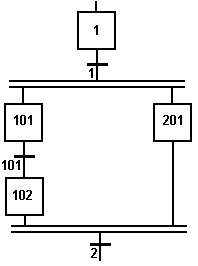
Processing of parallel branches may take different timing according to each branch execution.
The transition after the convergence (2 on this example) is crossed when all the steps connected before the convergence line (last step of each branch) are active. The transition indicates a synchronization of all parallel branches.
If needed, a branch may be finished with an "empty" step (with no action). It represents the state where the branch "waits" for the other ones to be completed.